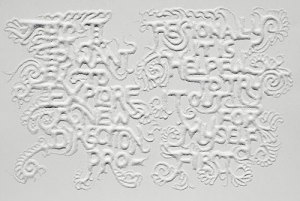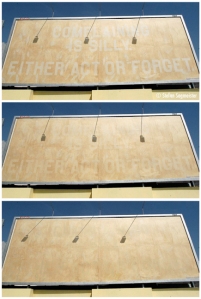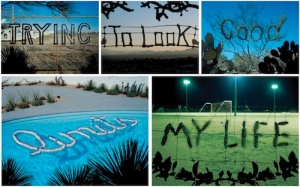(All quotations in this post have been drawn from “Things I Have Learned In My Life So Far” – Stefan Sagmeister, 2008, Abrams. Because the ‘book’ is divided into 15 booklets in side a slipcase, none with any page numbers or titles, I have been unable to provide page numbers for citations.)
What makes design distinct from art? Where do you draw the line? What makes this piece of work art, and this piece of work design? And why? These questions have been playing on my mind for the last 17 years. I felt that Stefan Sagmeister might provide some insight into this tricky inquiry, as he is the first contemporary graphic designer who springs to mind when imaging someone who continues to cross those boundaries.
“After running a design studio in New York for seven years, I decided in 2000 to conduct an experimental year, a year in which I would design no projects for clients but investigate how the work would change with no outside briefs or deadlines attached.”
“Thing I Have Learned In My Life So Far” showcases the projects that Sagmeister’s studio was commissioned to create (by paying clients) after he took a year to work independently of clients and the constraints of The Brief. He created experimental works entirely outside the comfort zone of the role he was used to as ‘Professional Graphic Designer’ and strayed from the well defined constrains of ‘Design’ into what most considered ‘Art’. After seeing the work he produced in his ‘year off’, clients were inspired themselves to give him free artistic reign to create something for them. It was a designer’s dream! Basically they were saying to him “Here’s the money, here’s the placement, do whatever you want.”
Stefan Sagmeister, Diary entry from June 30, 2000:
“Graphic design is a language. So, of course, I can go and learn another language, like film or music … and after some significant training I’ll be able to speak them in a way other people understand …
Or, instead of learning a new language, I can refine the one that I do know how to speak – graphic design – and, much more importantly, figure out if I actually have something to say. It would be maddening to spend ten years learning how to direct a film only to find out I have nothing to say. It might me more romantic to say “I love you” in French than it is in Cantonese: nevertheless, it is still possible to say it. It might be more touching to say it in a song than in design, but saying it in design should be achievable, too. And it is possible to say “I love you” even in architecture, as the Taj Mahal proves.”
While working with the language of graphic design without client and budget constraints, Sagmeister realised that he had the competency to push all the boundaries he felt constricted by in the commercial design world. His work, informed by the language of graphic design, became something else. There was no obvious product or service being marketed, the work was open to the interpretation of the viewer rather than communicating a direct call-to-action, but at the same time there are products and brand identities being marketed by the very fact that companies were paying to be associated with Sagmeisters creativity and design flair. As Nancy Spector writes:
“Stefan Sagmeister’s series Things I Have Learned In My Life So Far refuses to behave itself. Drawn from an inventory of aphoristic thoughts compiled in his diary, this unruly project claims to be graphic design and not art. After all it’s numerous instalments were generated by commissions with commercial applications. Behind the facade of personal revelation, there were indeed products to endorse and brand identities to convey. However despite Sagmeister’s insistence otherwise, Things I Have Learned in My Life So Far occupies a space associated with art – specifically, the space of mass-media communication appropriated by Conceptual artists to escape the confines of the gallery system.” – Nancy Spector, Chief Curator, Guggenheim Museum, Essay “States of Wonder” in “Things I Have Learned in My Life So Far”, Stefan Sagmeister, 2008.
So what are the qualities that make art and design different? Sagmeister and his peers offer some interesting insights:
One of the possible differences lies in the utility of the work:
“If I design a chair and push it to become more and more uncomfortable, gradually minimising its utility until I cannot sit on it anymore, there will be a point where it ceases to become a chair and becomes sculpture.”
And another in the effect of it’s communication:
“… the essence of art is to foster the kind of uncertainty that results in questions, while the role of design is to enhance communications that can lead to answers.” – Steven Heller, Design Critic and Historian, Essay in “Things I Have Learned in My Life So Far”, Stefan Sagmeister, 2008.
When talking about one of the spreads he worked on, “Everything I do always comes back to me”, Sagmeister discusses the dialogue he wishes to open with the viewer which leaves questions unanswered and room for personal interpretation:
“I purposely avoided turning the typography into a direct reflection of the content (say, by forcing the type into a circle closing in on itself), thinking that, considering the straightforwardness of the sentences, matching straightforward typographic form would create a closed system requiring no mental participation of viewers and consequently leaving them unengaged.
We designed the type referencing events, people and places whose meaning might not be easily recognised by an audience (e.g. the onion rings forming ‘I do’ reference ny mentor Tibor Kalman’s onion ring collection). Even though I am, in general, not a big fan of ambitious design (“the viewer can take whatever he or she wants:), in this instance I thought I would leave the system open and create room for an audience to relate.”
I think that all of these qualities are present in separating design from art, but it still feels like a complex and difficult boundary. The ideas of utility of purpose and the directness of the communication (usually eliciting a desired action or outcome) are certainly areas I have identified in my practices as both commercial designer and artist. I don’t feel that the commercial transaction (e.g. a piece commissioned by a client) is a relevant differentiator, as artworks can be commissioned, be paid for and, therefore, be items of commerce without losing their legitimacy as ‘art’ pieces. But maybe the ‘Design Brief’ is a differentiator as the client is able to dictate the desired outcome of a design project, but does not usually do this for an artwork (except, historically, a portrait work).
 “If I Want To Explore A New Direction Professionally, It Is Helpful To Try It Out For Myself First”.
“If I Want To Explore A New Direction Professionally, It Is Helpful To Try It Out For Myself First”.
Typography created by Marian Bantjes.
“I, like Stefan, also try out new directions and experiments on my own, which often end up in the professional realm later on. Creating in sugar is one of these things …” – Marian Bantjes, quote in “Things I Have Learned in My Life So Far”, Stefan Sagmeister, 2008.
This piece was interesting to me because it was a collaboration between two ‘designer’ who are also ‘artists’ by taking an experimental approach to their creativity in order to free themselves from the confines of The Design Brief, before bringing what they have discovered back to their commercial practices.
 “Complaining is Silly. Either Act or Forget”.
“Complaining is Silly. Either Act or Forget”.
“The billboard commissioned for Lisbon by Portuguese beer brand Super Bock consists of twenty large sheets of regular newsprint paper. We took advantage of the fact that newsprint yellows significantly in the sun and built gigantic cardboard stencils for the 3 x 8 metre billboard on the roof of our studio in New York. After the newsprint was exposed to the sunlight for a full week, we removed the stencils. the areas underneath remained completely white, while the surrounding background had turned yellow, and the text became readable: Complaining is silly. Either act or forget.
We rolled the exposed newsprint up and shipped it to Lisbon, where it was put up in a very sunny spot in front of the Centro Cultural de Bélem. Within a week the typography (and all the complaining) slowly faded away.” – “Things I Have Learned in My Life So Far”, Stefan Sagmeister, 2008.
I liked the ephemeral nature of this work and how it’s message was conveyed by the lifecycle of the substrate on which it was displayed.
 “Trying to Look Good Limits My Life”
“Trying to Look Good Limits My Life”
“The billboards … were installed in groups so a viewer could see them all from a single vantage point. No product to promote, no service to sell – an advertisement made solely for the enjoyment of the audience.”
This piece was interesting because of the way it acts like an advertisement, but the message being advertised is very personal, is not selling a product or a brand, but is definitely promoting a clearly articulated idea to it’s audience.
 “Money Does Not Make Me Happy”
“Money Does Not Make Me Happy”
“As viewers walked down the main pedestrian zone in Linz, they first noticed only the gigantic word money printed seven stories high on the pitch-black casino. Only as they passed the building and looked down the side street did the rest of the maxim reveal itself.”
Getting paid to promote the idea that money does not equal happiness must be the ultimate coup!